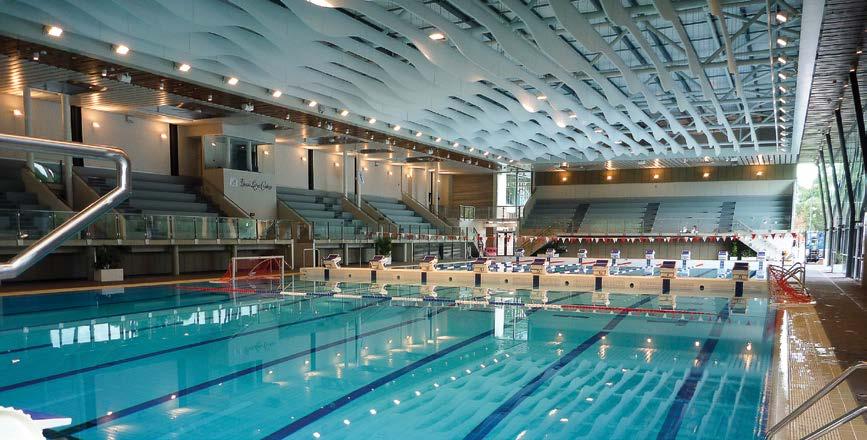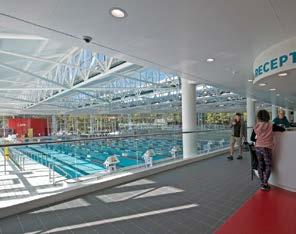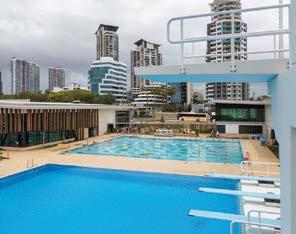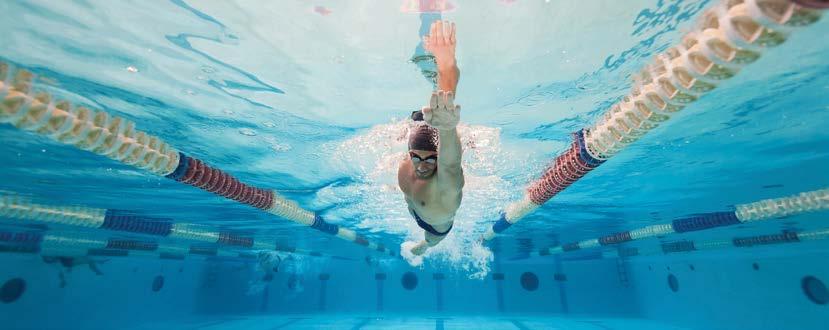
10 minute read
Aquatic Facilities
Gas bill shock triggers revolution in energy-efficient aquatic centre design
by Poppy Johnston, The Fifth Estate (www.thefifthestate.com.au)
Advertisement
Poppy Johnston, journalist with The Fifth Estate, has been looking into the impact of rising energy costs on council owned and operated aquatic centres - and what can be done to help improve energy efficiency and reduce the environmental impact and operating costs of these critical public infrastructure assets.
As Australian councils struggle to pay sky-high gas bills to heat and cool their aquatic centres, pressure is building to find cheaper and less carbon-intensive ways to keep these treasured community facilities open.
Australia might be a leader on building energy performance, but one niche building type appears to have largely fallen through the cracks: the local aquatic centre.
According to experts, historically cheap gas prices and the absence of a carbon tax has spawned a fleet of energy-hungry aquatic facilities across the country. These facilities, which typically consist of indoor pools and other functions such as gyms and cafes, can consume up to seven times more energy per floor area than the average commercial office building.
This could soon change, with councils now facing enormous bills thanks to rising gas prices that aren’t expected to decline. One source from a metropolitan Victorian council told The Fifth Estate that the council’s energy bill had increased by more than 60 per cent compared with 2014-2017 averages.
Fortunately, there’s growing evidence to suggest it’s possible to design and retrofit aquatic centres to dramatically improve energy efficiency.
Northern Environmental Design director Jonathan Duverge, whose PhD focussed on energy efficiency in aquatic centres, says Europe leads the way on aquatic centre design.
“Higher energy costs have prompted the design of better performing buildings,” he explains, “with, for example, minimal use of glass.”
“It’s very rare to see an aquatic centre with floor-to-ceiling glass surrounding it… Europe is really looking at the design,” he said.
By contrast, large swathes of glazing are common in Australian aquatic centres. While it might look attractive, sky lights and floor-toceiling glazing attracts condensation. If not managed correctly, glare can also be dangerous inside an aquatic centre.
Steel framing is also common in Australian aquatic centres, creating thermal bridges and attracting condensation and rust.
Duverge says that in Australia it’s rare for designers to consider how much energy the facility is going to use – it’s all about making them “tall and shiny”.
“It doesn’t help that fully-glazed domes are recognised by the industry as tender-winning designs,” he adds.
He says also people don’t understand the effect of evaporation and heat loss that occurs in an indoor pool. “They treat it as an office building.” He says the evaporative effect has a big impact on energy consumption, but is rarely taken into consideration.
“I think people just try to do calculations in terms of heating but neglect the effect of evaporation. That’s not really accurate.”
Another common problem is that aquatic centre staff are not trained or don’t understand how HVAC systems work, opening windows and doors when it becomes too hot rather than adjusting the HVAC.
Duverge is seeing change in the industry as councils start to feel the financial and ethical pressure, with many declaring a climate emergency and looking for opportunities to decarbonise their operations.
CAPTURING HEAT ENERGY For RMIT senior industry fellow Alan Pears, an energy efficiency expert who’s been looking into the energy performance of aquatic centres since the 1990s, the key issue for aquatic centres is that they flush out enormous amounts of heat energy that is costly to produce. Most of the thermal energy going into an aquatic centre is used to heat the air around the pool, followed by the pool water itself which is heated to around 27-29 degrees Celsius. The warm water from the pool evaporates, absorbing large amounts of energy, producing water vapour and making the pool facility hot and steamy.
Air extraction fans are required to suck out the hot, humid air and the energy it contains at an astounding rate. Air equivalent to 4 to 10 times the volume of the building is exhausted and replaced by outdoor air every hour.
The good news is there’s a tried and tested technology that can capture and upgrade this escaping heat energy for another use – the heat pump.
HOW IT WORKS A heat pump is an electrical device that extracts heat from one place and transfers it to another. Refrigerators and air conditioners are both heat pumps but only for cooling. The heat pump cycle is fully reversible, and can provide heating in winter and cooling in summer.
Unlike traditional heating equipment that only generates heat, the pumps extract heat from the environment – as per the laws of thermodynamics, where even cold air, heat or other materials actually contains a lot of heat energy.
In an aquatic centre, a heat pump is particularly attractive as it is able to capture the large amounts of waste heat energy from humid exhaust air and “pump” it back into the pool, all while using a relatively small amount of electricity.
This all ends up being far cheaper because, although the price per unit of energy is more than gas, a heat pump is much more efficient than a gas boiler in this kind of setting.
A heat pump’s energy efficiency is measured by its Coefficient of Performance (CoP), which is the amount of heating or cooling provided by a heating or cooling unit to the energy consumed by the system. A top-of-the-line heat pump can have a CoP as high as 9.5 to 11 (950-1100 per cent), compared with traditional gas boilers that have an expected efficiency of around 50-75 per cent.
The efficiency of heat pumps increases again if used as an integrated building-wide system for both heating and cooling. This makes the technology even more attractive for aquatic centres because different spaces and pools are heated at different temperatures. For example, a gym needs to be at a comfortable temperature for exercising, while a pool in the same centre needs to be about 30 degrees.
Pears says that once you start running the numbers, heat pumps “look pretty good,” with lower maintenance and running costs offsetting the higher capital costs over time.
COUNCILS TURN TO AMMONIA HEAT PUMPS SmartConsult renewable energy consultant Derek Harbison believes low-charge ammonia heat pumps are a good option for those aquatic centres considering the shift away from gas.
Harbison, who has been acting as an intermediary between councils and the refrigeration industry, says the technology is proven and already used in other building types in Australia, such as commercial buildings and cold stores. A key benefit of these systems is that they rely on a “natural” refrigerant that doesn’t contribute to global warming.
Critically, he says a fully integrated and optimised system has the potential to make an aquatic centre 80 per cent more efficient when compared with a comparable gas system.
Harbison has been approached by multiple councils from Victoria and NSW interested in alternatives to gas for heating and cooling their aquatic centres.
Elite Thermal Covers keep everyone happy.

Save your Centre thousands on the cost of: • Heating • Water & chemicals • Building Maintenance
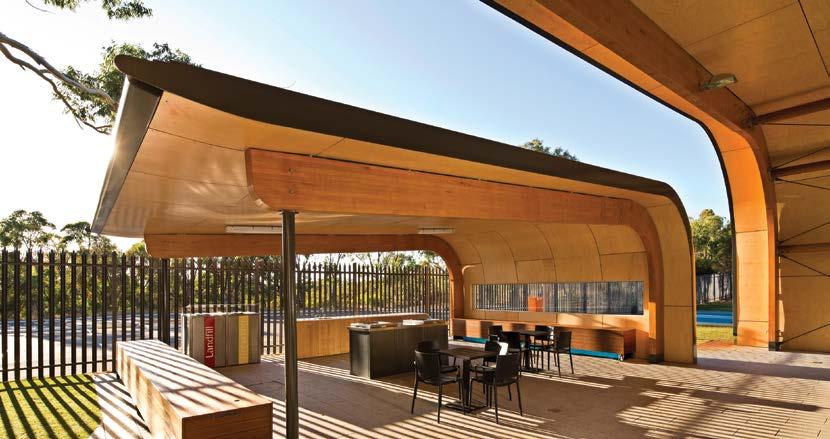
ESD made easy Uncovering the true value of pool covers
The key purpose of Environmentally Sustainable Design (ESD) is to reduce impacts in both the construction and use of buildings, structures and facilities on the natural environment, whilst at the same time improving comfort and amenity for the inhabitants and/or those using the facilities. With that in mind, it’s also clear that when it comes to ‘best practice’ ESD, indoor pools and large aquatic centres can present some of the largest challenges when it comes to design, construction and ongoing operation. From energy consumption; water consumption; and reducing emissions, through to chemical use; public and staff health & safety requirements; and maintenance requirements (in what can be an extremely harsh and corrosive environment) – ‘ticking all of the ESD boxes’, whilst at the same time providing a facility which is fun, safe and financially viable is no easy task.
Importantly, there is one easy, highly costeffective and proven method of significantly reducing the environmental impact of both new and existing pools and aquatic centres – install a pool cover.
Bernard Schenk, Commercial Sales Manager with leading commercial pool equipment specialists Elite Pool Covers, explained:
“Installing a good quality commercial pool cover can not only significantly reduce water loss through evaporation, it can also, quite literally, end up saving the facility owner tens (or even hundreds) of thousands of dollars in operating and maintenance costs.” “From reduced energy bills for water heating, through to the extended painting and maintenance intervals that can result from reducing the amount of condensation being generated in indoor aquatic facilities, a commercial pool cover can not only significantly boost a facility’s ESD credentials, it’s also an excellent financial investment,” he added.
Alarmingly, despite these many ESD and cost benefits, around 50% of commercial pools still don’t have pool covers fitted, with pool owners/operators citing reasons including capital cost, limited space for covers, no staff available to operate covers, etc. Indeed, even where a pool cover had been included as part of the pool construction or refurbishment project, the pool cover is often the first item to ‘get cut’ in an attempt to reduce costs if the project has run over time and/ or over budget.
Considering that the average ‘payback’ of the capital cost of a commercial pool blanket in direct water and energy savings is around 18 months, there’s a fair argument that pool blankets should no longer be considered as an ‘optional extra’ – rather as a mandatory inclusion.
As for the available floor space argument, that too is no longer an issue – thanks to a number of innovative new designs from Elite Pool Covers.
“Massive increases in the cost of land, has meant that buildings are getting smaller and facilities are becoming more compact,” Bernard Schenk explained.
Now you see it – now you don’t. This built-in pool cover system makes the most of valuable space by storing the pool cover under the pool deck when it’s not in use.

“The square metre value of floorspace is significantly higher than it was 10 years ago and it continues to go up – and facility owners don’t want to spend that money to simply provide space to store a pool cover when it’s not on the pool”.
“With that in mind, we’ve developed a range of solutions to overcome that issue, including built-in systems which are concealed in the pool deck and moveable systems which double as seating around the pool deck,” he said.
“These options, combined with the many ESD and financial benefits, mean that there really is no excuse for not including a pool cover as part of your pool design.”
“Most importantly, like most things, pre-planning delivers the best results,” he added. “Including a pool cover in the design of a new facility or in refurbishment plans for an existing facility enables us to design and deliver the most efficient solution – in terms of both environmental performance, aesthetics and usability.”
For further information, please contact Elite Pool Covers on T: 1300 136 696 or visit the website: www.poolcovers.com.au



